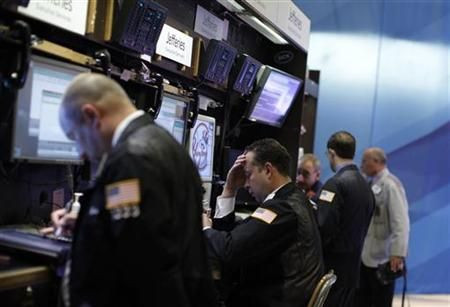Downgradeageddon: U.S. Markets Plummet as Fear Takes Hold

Fear dominated the U.S. stock markets Monday as S&P's action turned to downgradeageddon.
By late in the trading day, the Dow was down 4 percent, the Nasdaq almost 6 percent, and the S&P 500 index more than 5.5 percent.
Art Cashin, floor director on the New York Stock Exchange for UBS Securities, told the Associated Press the situation was like watching a patient recovering from chest pain as he walks down the street.
"You wait as they catch their breath, and see if they can walk on," said Cashin, who has worked the NYSE floor for 50 years. "But the symptoms are concerning."
President Barack Obama addressed the nation in the afternoon about S&P's downgrade of the U.S. debt rating, but his words only fueled a higher selloff on Wall Street.
"The fact is," Obama said, "we didn't need a rating agency to tell us we need a balanced, longer-term approach to deficit reduction: That was true last week, that was true last year, that was true the day I took office."
Obama also said the U.S. remains after the S&P downgrade a "AAA country."
"Markets will rise and fall," Obama said, "but this is the United States of America. No matter what some agency may say, we have always been and always will be a triple-A country."
But that didn't suffice for Wall Street, as indexes already heavily in the red plunged lower.
Doubts that politicians in Washington and leading European countries facing debt issues can fix their problems fast enough loom large.
"We have so many issues that it's hard to see how we're going to work our way ouf of them, as much as anything with the political issues," Susan Fulton, founder and principal at FBB Capital Markets in Bethesda, Md., said in an interview with CNBC. "We don't seem to be helping ourselves. Not only are we in trouble but we're trying to drown that man that's come out to save us."
The drop in the markets Monday follows Wall Street's worst week since March 2009, during the recession.
Also, the CBOE Volatility Index, considered by many the best gauge of fear in the markets, rose above 40, climbing 39 percent to 44.80, for the first time since May 2010.
Bank of Amerca was the worst performing Dow stock, dropping more than 21 percent, or $1.75, to $6.41 by 2:30 p.m. Monday. The bank's stock was falling in the downgrade aftermath with other financial stocks, but it was also hit hard by news that AIG is suing Bank of America over mortgage-backed securities losses.
Also dragging on the markets was news Monday that S&P has subsequently downgraded Fannie Mae and Freddie Mac and several other agencies that rely upon the federal government's ability to pay its debt.
The S&P spoke out Monday, addressing criticism that it was overzealous in its debt rating downgrade of the U.S., and had made a $2 trillion error.
"The idea that we made a $2 trillion error is simply a smokescreen for the unhappiness, in our view, about our decision," said David Beers, S&P's global head of sovereign ratings, in an interview on CNN's "American Morning."
But S&P's downgrade spread investor fear well beyond the U.S. Overnight Hong Kong's Hang Seng Index and Japan's Nikkei 225 Stock Average slid more than 2 percent and the Shanghai Composite Index lost nearly 4 percent.
Europe's debt crisis had already shaken global markets and the U.S. market in recent weeks, but Friday's downgrade by one notch of the U.S. debt rating from AAA to AA+ by the ratings agency Standard & Poor's shook more fear into global markets.
In Hong Kong and China, shares fell to their lowest level since 2010, as retail investors sold bank stocks and cyclical industrials on the news of the downgrade.
"People are trading in fear at the moment," said Hong Hao, a global strategist at CICC, in an interview with Reuters.
© Copyright IBTimes 2025. All rights reserved.





















